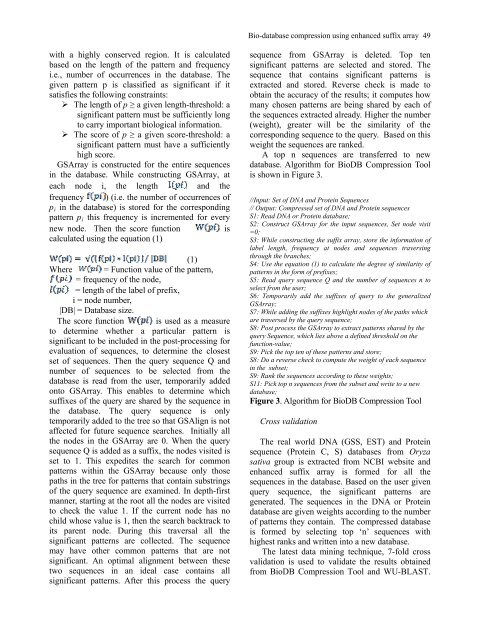Vol 9 No1 - Journal of Cell and Molecular Biology - Haliç Üniversitesi
Vol 9 No1 - Journal of Cell and Molecular Biology - Haliç Üniversitesi
Vol 9 No1 - Journal of Cell and Molecular Biology - Haliç Üniversitesi
You also want an ePaper? Increase the reach of your titles
YUMPU automatically turns print PDFs into web optimized ePapers that Google loves.
with a highly conserved region. It is calculated<br />
based on the length <strong>of</strong> the pattern <strong>and</strong> frequency<br />
i.e., number <strong>of</strong> occurrences in the database. The<br />
given pattern p is classified as significant if it<br />
satisfies the following constraints:<br />
The length <strong>of</strong> p ≥ a given length-threshold: a<br />
significant pattern must be sufficiently long<br />
to carry important biological information.<br />
The score <strong>of</strong> p ≥ a given score-threshold: a<br />
significant pattern<br />
must have a sufficiently<br />
high score.<br />
GSArray is constructed for the entire sequences<br />
in the database. While constructing GSArray, at<br />
each node i, the length <strong>and</strong> the<br />
frequency ) (i.e. the number <strong>of</strong> occurrences <strong>of</strong><br />
pi in the database) is stored for the corresponding<br />
pattern pi this frequency is incremented for every<br />
new node. Then the score function<br />
is<br />
calculated using the equation (1)<br />
(1)<br />
Where = Function value <strong>of</strong> the pattern,<br />
= frequency <strong>of</strong> the node,<br />
= length <strong>of</strong> the label <strong>of</strong> prefix,<br />
i = node number,<br />
|DB| = Database size.<br />
The score function is used as a measure<br />
to determine whether a particular pattern is<br />
significant to be included in the post-processing for<br />
evaluation <strong>of</strong> sequences, to determine the closest<br />
set <strong>of</strong> sequences. Then the query sequence Q <strong>and</strong><br />
number <strong>of</strong> sequences to be selected from the<br />
database is read from the user, temporarily added<br />
onto GSArray. This enables to determine which<br />
suffixes <strong>of</strong> the query are shared by the sequence in<br />
the database. The query sequence is only<br />
temporarily added to the tree so that GSAlign is not<br />
affected for future sequence searches. Initially all<br />
the nodes in the GSArray are 0. When the query<br />
sequence Q is added as a suffix, the nodes visited is<br />
set to 1. This expedites the search for common<br />
patterns within the GSArray because only those<br />
paths in the tree for patterns that contain substrings<br />
<strong>of</strong> the query sequence are examined. In depth-first<br />
manner, starting at the root all the nodes are visited<br />
to check the value 1. If the current node has no<br />
child whose value is 1, then the search backtrack to<br />
its parent node. During this traversal all the<br />
significant patterns are collected. The sequence<br />
may have other common patterns that are not<br />
significant. An optimal alignment between these<br />
two sequences in an ideal case contains all<br />
significant patterns. After this process the query<br />
Bio-database compression using enhanced suffix array 49<br />
sequence from GSArray is deleted. Top ten<br />
significant patterns are selected <strong>and</strong> stored. The<br />
sequence that contains significant patterns is<br />
extracted <strong>and</strong> stored. Reverse check is made to<br />
obtain the accuracy <strong>of</strong> the results; it computes how<br />
many chosen patterns are being shared by each <strong>of</strong><br />
the sequences extracted already. Higher the number<br />
(weight), greater will be the similarity <strong>of</strong> the<br />
corresponding sequence to the query. Based on this<br />
weight<br />
the sequences are ranked.<br />
A top n sequences are transferred to new<br />
database. Algorithm for<br />
BioDB Compression Tool<br />
is shown in Figure 3.<br />
//Input: Set <strong>of</strong> DNA <strong>and</strong> Protein Sequences<br />
// Output: Compressed set <strong>of</strong> DNA <strong>and</strong> Protein sequences<br />
S1: Read DNA or Protein database;<br />
S2: Construct GSArray for the input sequences, Set node visit<br />
=0;<br />
S3: While constructing the suffix array, store the information <strong>of</strong><br />
label length, frequency at nodes <strong>and</strong> sequences traversing<br />
through the branches;<br />
S4: Use the equation (1) to calculate the degree <strong>of</strong> similarity <strong>of</strong><br />
patterns in the form <strong>of</strong> prefixes;<br />
S5: Read query sequence Q <strong>and</strong> the number <strong>of</strong> sequences n to<br />
select from the user;<br />
S6: Temporarily add the suffixes <strong>of</strong> query to the generalized<br />
GSArray;<br />
S7: While adding the suffixes highlight nodes <strong>of</strong> the paths which<br />
are traversed by the query sequence;<br />
S8: Post process the GSArray to extract patterns shared by the<br />
query Sequence, which lies above a defined threshold on<br />
the<br />
function-value;<br />
S9: Pick the top ten <strong>of</strong> these patterns <strong>and</strong> store;<br />
S8: Do a reverse check to compute the weight <strong>of</strong> each sequence<br />
in the subset;<br />
S9: Rank the sequences according to these weights;<br />
S11: Pick top n sequences from the subset <strong>and</strong> write to a new<br />
database;<br />
Figure 3. Algorithm for BioDB Compression Tool<br />
Cross validation<br />
The real world DNA (GSS, EST) <strong>and</strong> Protein<br />
sequence (Protein C, S) databases from Oryza<br />
sativa group is extracted from NCBI website <strong>and</strong><br />
enhanced suffix array is formed for all the<br />
sequences in the database. Based on the user given<br />
query sequence, the significant patterns are<br />
generated. The sequences in the DNA or Protein<br />
database are given weights according to the number<br />
<strong>of</strong> patterns they contain. The compressed database<br />
is formed by selecting top ‘n’ sequences with<br />
highest<br />
ranks <strong>and</strong> written into a new database.<br />
The latest data mining technique, 7-fold cross<br />
validation is used to validate the results obtained<br />
from BioDB Compression Tool <strong>and</strong> WU-BLAST.

















